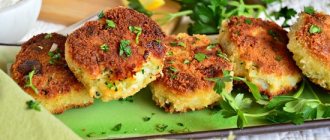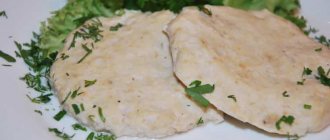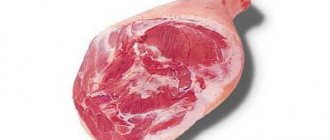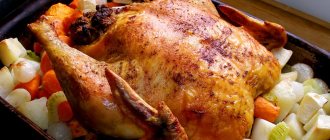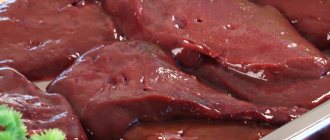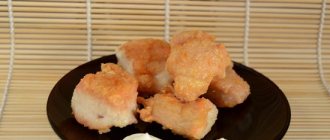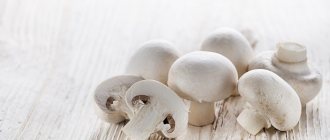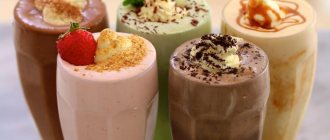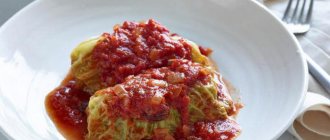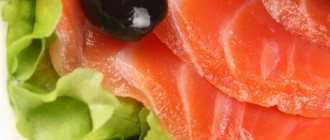How many calories are in a fried fish cutlet?
There is hardly a person who can resist the aroma of a fish cutlet fried until golden brown. To assess the nutritional value of this dish, it is necessary to take into account a number of factors - what product was used to prepare the minced meat, what components were added, what type of cooking was chosen.
Generally speaking, the calorie content of fish cutlets can vary from 70 to 400 kilocalories per 100 g of product. Intrigued? Let's look at this issue in more detail.
You can make cutlets from different types of fish. Some people prefer to make them from hake or pollock, while others like delicacy options, for example, from pink salmon or trout. And some are simply crazy about cutlets made from pike fillet. How many calories are in a pike fish cake? These cutlets are considered one of the most delicious and high-calorie. A 100-gram serving will contain approximately 240 kilocalories.
How many calories are in a pink salmon fish cutlet? This dish will please everyone who is on a diet, because its nutritional value barely reaches 90 kilocalories. Another popular option is pollock. The fish is inexpensive, accessible and healthy for everyone. The nutritional value of pollock cutlets can vary from 40 to 104 kilocalories. In this case, much depends on the chosen method of heat treatment.
On a note! When fried in vegetable oil, the cutlets absorb additional fat, and accordingly, the calorie content increases. At the same time, under the influence of high temperatures, carcinogens begin to be produced that are dangerous to human health.
It has already been said that the calorie content of cutlets made from fish fillets depends directly on the method of heat treatment. The dish has maximum nutritional value when fried. How many calories are in a fish cutlet in the oven? A 100-gram serving will contain about 67 kilocalories. This figure may be lower or higher depending on what type of fish was chosen.
Steamed cutlets are considered the healthiest, enriched with vitamins and other components. Do you know how many calories are in a steamed fish cutlet? About 83 kilocalories.
On a note! If we talk about the ratio of proteins, fats and carbohydrates, then the former play a leading role, because there are more than 50% of them in fish cutlets. Next come carbohydrates, but very little fat. But these indicators may vary depending on the type of fish fillet.
Recipe: Fried fish cutlet. Calorie, chemical composition and nutritional value.
Nutritional value and chemical composition of “Fried fish cutlet”.
The table shows the nutritional content (calories, proteins, fats, carbohydrates, vitamins and minerals) per 100 grams of edible portion.
| Nutrient | Quantity | Norm** | % of the norm in 100 g | % of the norm in 100 kcal | 100% normal |
| Calorie content | 141.9 kcal | 1684 kcal | 8.4% | 5.9% | 1187 g |
| Squirrels | 15.7 g | 76 g | 20.7% | 14.6% | 484 g |
| Fats | 7.2 g | 56 g | 12.9% | 9.1% | 778 g |
| Carbohydrates | 3.7 g | 219 g | 1.7% | 1.2% | 5919 g |
| Alimentary fiber | 0.7 g | 20 g | 3.5% | 2.5% | 2857 g |
| Water | 70.7 g | 2273 g | 3.1% | 2.2% | 3215 g |
| Ash | 2.23 g | ~ | |||
| Vitamins | |||||
| Vitamin A, RE | 95.2 mcg | 900 mcg | 10.6% | 7.5% | 945 g |
| Retinol | 0.028 mg | ~ | |||
| alpha carotene | 274.601 mcg | ~ | |||
| beta carotene | 0.659 mg | 5 mg | 13.2% | 9.3% | 759 g |
| Lycopene | 0.079 mcg | ~ | |||
| Lutein + Zeaxanthin | 20.217 mcg | ~ | |||
| Vitamin B1, thiamine | 0.122 mg | 1.5 mg | 8.1% | 5.7% | 1230 g |
| Vitamin B2, riboflavin | 0.128 mg | 1.8 mg | 7.1% | 5% | 1406 g |
| Vitamin B4, choline | 22.33 mg | 500 mg | 4.5% | 3.2% | 2239 g |
| Vitamin B5, pantothenic | 0.143 mg | 5 mg | 2.9% | 2% | 3497 g |
| Vitamin B6, pyridoxine | 0.124 mg | 2 mg | 6.2% | 4.4% | 1613 g |
| Vitamin B9, folates | 13.424 mcg | 400 mcg | 3.4% | 2.4% | 2980 g |
| Vitamin B12, cobalamin | 2.088 mcg | 3 mcg | 69.6% | 49% | 144 g |
| Vitamin C, ascorbic acid | 1.94 mg | 90 mg | 2.2% | 1.6% | 4639 g |
| Vitamin D, calciferol | 1.455 mcg | 10 mcg | 14.6% | 10.3% | 687 g |
| Vitamin E, alpha tocopherol, TE | 2.389 mg | 15 mg | 15.9% | 11.2% | 628 g |
| beta tocopherol | 0.001 mg | ~ | |||
| Vitamin H, biotin | 2.611 mcg | 50 mcg | 5.2% | 3.7% | 1915 |
| Vitamin K, phylloquinone | 1 mcg | 120 mcg | 0.8% | 0.6% | 12000 g |
| Vitamin RR, NE | 4.1784 mg | 20 mg | 20.9% | 14.7% | 479 g |
| Niacin | 1.183 mg | ~ | |||
| Betaine | 0.031 mg | ~ | |||
| Macronutrients | |||||
| Potassium, K | 344.46 mg | 2500 mg | 13.8% | 9.7% | 726 g |
| Calcium, Ca | 39.57 mg | 1000 mg | 4% | 2.8% | 2527 g |
| Silicon, Si | 0.124 mg | 30 mg | 0.4% | 0.3% | 24194 g |
| Magnesium, Mg | 33.99 mg | 400 mg | 8.5% | 6% | 1177 g |
| Sodium, Na | 407.52 mg | 1300 mg | 31.3% | 22.1% | 319 g |
| Sera, S | 195.13 mg | 1000 mg | 19.5% | 13.7% | 512 g |
| Phosphorus, P | 232.3 mg | 800 mg | 29% | 20.4% | 344 g |
| Chlorine, Cl | 662.34 mg | 2300 mg | 28.8% | 20.3% | 347 g |
| Microelements | |||||
| Aluminium, Al | 41.6 mcg | ~ | |||
| Bor, B | 22.9 mcg | ~ | |||
| Vanadium, V | 2.81 mcg | ~ | |||
| Iron, Fe | 0.973 mg | 18 mg | 5.4% | 3.8% | 1850 g |
| Yod, I | 138.52 mcg | 150 mcg | 92.3% | 65% | 108 g |
| Cobalt, Co | 18.556 mcg | 10 mcg | 185.6% | 130.8% | 54 g |
| Manganese, Mn | 0.1611 mg | 2 mg | 8.1% | 5.7% | 1241 g |
| Copper, Cu | 140.26 mcg | 1000 mcg | 14% | 9.9% | 713 g |
| Molybdenum, Mo | 5.211 mcg | 70 mcg | 7.4% | 5.2% | 1343 g |
| Nickel, Ni | 6.284 mcg | ~ | |||
| Rubidium, Rb | 49.6 mcg | ~ | |||
| Selenium, Se | 2.793 mcg | 55 mcg | 5.1% | 3.6% | 1969 |
| Fluorine, F | 605.55 mcg | 4000 mcg | 15.1% | 10.6% | 661 g |
| Chromium, Cr | 47.51 mcg | 50 mcg | 95% | 66.9% | 105 g |
| Zinc, Zn | 0.9909 mg | 12 mg | 8.3% | 5.8% | 1211 g |
| Digestible carbohydrates | |||||
| Starch and dextrins | 2.192 g | ~ | |||
| Mono- and disaccharides (sugars) | 1.3 g | max 100 g | |||
| Galactose | 0.003 g | ~ | |||
| Glucose (dextrose) | 0.19 g | ~ | |||
| Maltose | 0.036 g | ~ | |||
| Sucrose | 0.962 g | ~ | |||
| Fructose | 0.18 g | ~ | |||
| Essential amino acids | 0.03 g | ~ | |||
| Arginine* | 1.021 g | ~ | |||
| Valin | 0.877 g | ~ | |||
| Histidine* | 0.626 g | ~ | |||
| Isoleucine | 0.712 g | ~ | |||
| Leucine | 1.14 g | ~ | |||
| Lysine | 1.39 g | ~ | |||
| Methionine | 0.476 g | ~ | |||
| Methionine + Cysteine | 0.787 g | ~ | |||
| Threonine | 0.674 g | ~ | |||
| Tryptophan | 0.175 g | ~ | |||
| Phenylalanine | 0.623 g | ~ | |||
| Phenylalanine+Tyrosine | 1.033 g | ~ | |||
| Nonessential amino acids | 0.069 g | ~ | |||
| Alanin | 1.054 g | ~ | |||
| Aspartic acid | 1.641 g | ~ | |||
| Glycine | 0.632 g | ~ | |||
| Glutamic acid | 2.123 g | ~ | |||
| Proline | 0.786 g | ~ | |||
| Serin | 0.635 g | ~ | |||
| Tyrosine | 0.42 g | ~ | |||
| Cysteine | 0.318 g | ~ | |||
| Sterols (sterols) | |||||
| Cholesterol | 105.17 mg | max 300 mg | |||
| beta sitosterol | 8.549 mg | ~ | |||
| Saturated fatty acids | |||||
| Saturated fatty acids | 1.3 g | max 18.7 g | |||
| 14:0 Miristinovaya | 0.08 g | ~ | |||
| 15:0 Pentadecane | 0.001 g | ~ | |||
| 16:0 Palmitinaya | 0.76 g | ~ | |||
| 17:0 Margarine | 0.01 g | ~ | |||
| 18:0 Stearic | 0.365 g | ~ | |||
| 20:0 Arakhinovaya | 0.023 g | ~ | |||
| 22:0 Begenovaya | 0.03 g | ~ | |||
| Monounsaturated fatty acids | 1.923 g | min 16.8 g | 11.4% | 8% | |
| 16:1 Palmitoleic | 0.152 g | ~ | |||
| 17:1 Heptadecene | 0.001 g | ~ | |||
| 18:1 Oleic (omega-9) | 1.634 g | ~ | |||
| 20:1 Gadoleic (omega-9) | 0.097 g | ~ | |||
| Polyunsaturated fatty acids | 3.066 g | from 11.2 to 20.6 g | 27.4% | 19.3% | |
| 18:2 Linolevaya | 2.684 g | ~ | |||
| 18:3 Linolenic | 0.006 g | ~ | |||
| 20:4 Arachidonic | 0.024 g | ~ | |||
| Omega-3 fatty acids | 0.3 g | from 0.9 to 3.7 g | 33.3% | 23.5% | |
| 22:5 Docosapentaenoic acid (DPA), Omega-3 | 0.026 g | ~ | |||
| 22:6 Docosahexaenoic acid (DHA), Omega-3 | 0.324 g | ~ | |||
| Omega-6 fatty acids | 0.1 g | from 4.7 to 16.8 g | 2.1% | 1.5% |
The energy value of the fried fish cutlet is 141.9 kcal.
Primary Source: Created in the application by the user. Read more.
** This table shows the average levels of vitamins and minerals for an adult. If you want to know the norms taking into account your gender, age and other factors, then use the “My Healthy Diet” application.
"Fish" gold
Almost all people probably know that fish and other seafood contain large amounts of phosphorus, iodine and fatty acids. Accordingly, the use of such products brings great benefits to the human body. First of all, the functioning of the thyroid gland is normalized, iodine deficiency is replenished, which is extremely necessary for maintaining cognitive functions, hormonal levels and proper functioning of the brain. But this is not all the beneficial properties that fish and fish cutlets have.
Beneficial features:
- improving the condition of the skin and hair;
- prevention of the development of atherosclerosis;
- strengthening vascular walls;
- prevention of the development of inflammatory processes.
Nutritionists and gastroenterologists do not recommend eating cutlets fried at all. Give preference to baked dishes or steamed cutlets. By the way, in the latter version, all nutrients, vitamin components, micro- and macroelements are preserved in the fish to the maximum.
When calculating nutritional values, don't forget to consider what other ingredients you're adding. As a rule, minced fish is supplemented with chicken eggs, semolina, vegetables, and herbs.
Fish cutlets, benefits
Steamed cutlets - dietary dish
Before moving on to considering calorie content, you need to understand whether this product is healthy or is it better to replace the dish with simple steamed or fried fish?! In kindergartens, schools, and public canteens there are always fish cutlets on the menu. They are there not because their cost is quite low and cooking is not so difficult, but mostly because they have a number of positive and useful properties, among which are:
- Rapid absorption of fish protein by the body. The period of its absorption is approximately three hours
- Fish cutlets are much more tender and softer than meat cutlets, making them easy to eat even for small children
- Contains a large amount of vitamin D, which helps reduce cholesterol levels in the blood
- The content of vitamin B6 and B12 in fish suggests that fish helps strengthen the immune system, as well as normalize the functioning of the nervous system
- High content of various amino acids that are involved in the metabolism of substances such as calcium, sodium, etc.
- Has a positive effect on musculoskeletal composition, since fish contains phosphorus
The product contains almost all the necessary vitamins, microelements and minerals that the human body needs for normal functioning. That is why eating fish cutlets is not only profitable, but also very healthy.
You haven't tried anything like this before!
Fish cutlets can be prepared according to any recipe. The taste will depend on the fish you took. We invite you to take note of the original recipe for such a dish with the addition of pumpkin pulp. Let's take mackerel fillet as a basis. The cutlets will turn out healthy because we will bake them in the oven.
On a note! A fireproof pan can be lined with parchment paper or a silicone mat. In this case, you will not have to use oil.
Ingredients:
- fresh frozen mackerel fillet – 750 g;
- dried parsley - one teaspoon. spoon;
- ground allspice, salt;
- dried basil;
- selected chicken egg - one piece;
- semolina – 100 g;
- pumpkin pulp – 350 g;
- onion – 300 g.
Preparation:
- Let's start cutting the fish right away. We clean the mackerel, gut it and rinse thoroughly. We remove the ridge and remove large bones. Small bones will not be felt as a result of twisting in the meat grinder.
- Peel the pumpkin pulp.
- Peel the onion and cut each head into quarters to make it easier to chop.
- First, pass the pumpkin pulp through a meat grinder.
- Then add the fish fillet along with the onion.
- Mix the resulting mass and add a raw chicken egg.
- Combine dried basil and parsley in a mortar. Grind the bulk ingredients thoroughly.
- Add about one teaspoon to the minced meat and add salt.
- Season with ground allspice.
- Next, add semolina.
- Stir the minced meat vigorously to avoid lumps.
- We wet our hands with water and make cutlets. For convenience, you can put the minced meat in the refrigerator for a quarter of an hour.
- Transfer the cutlets to a fireproof dish so that they do not touch each other. Place in the oven.
- Set the temperature to 180° and bake for about half an hour.
